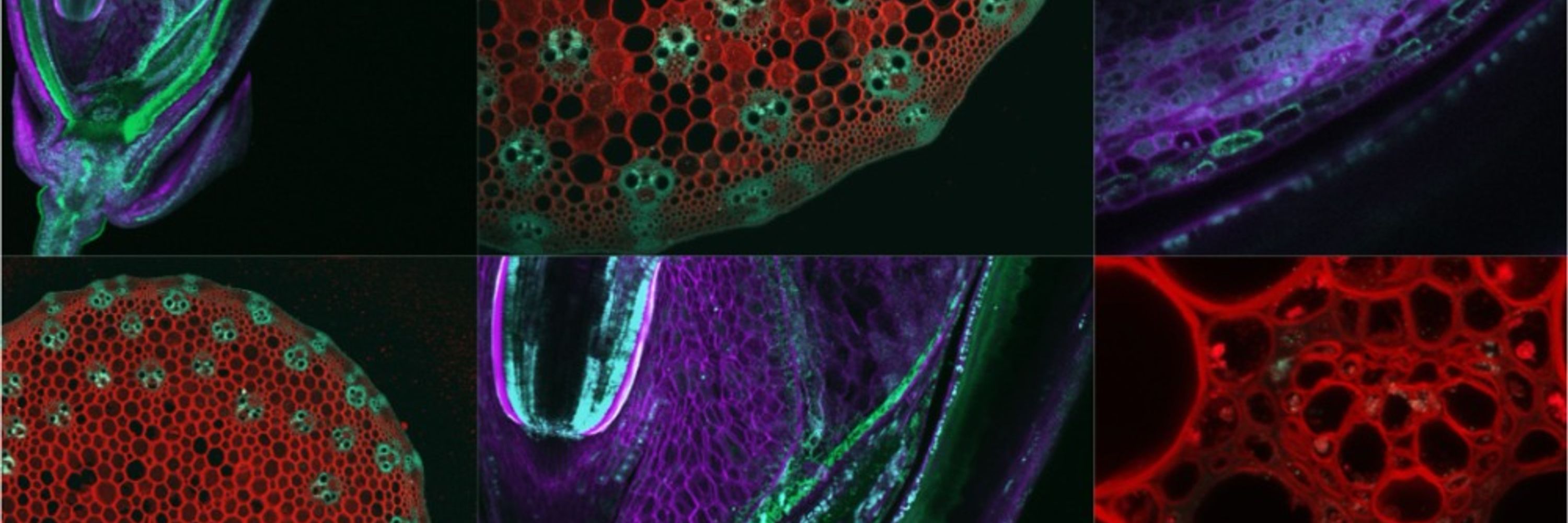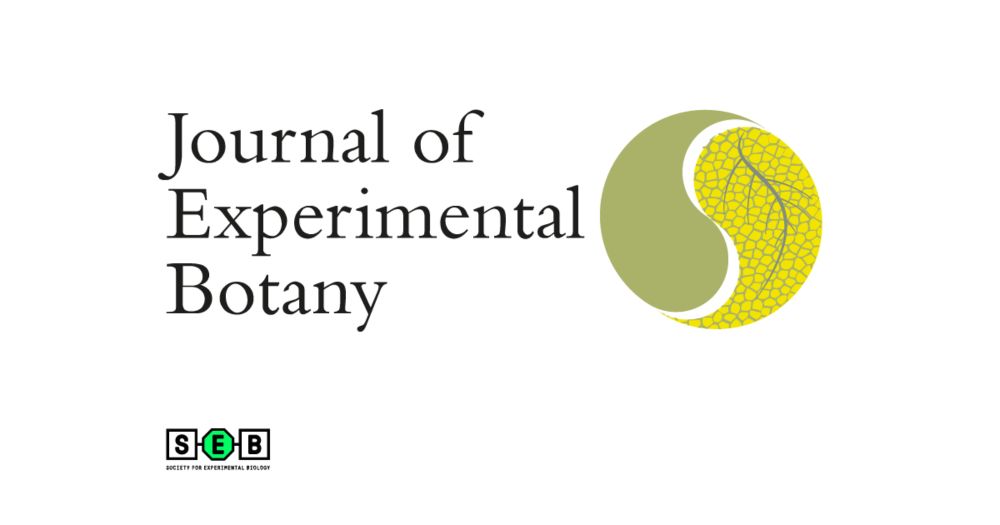
https://academic.oup.com/jxb
[email protected]

🌍 JXB Issue 20 of 2025 is out now 🌍
🍇🔥 On the cover: Wildfire smoke lingers in a vineyard in Davis, California in August 2020 - see Paineau et al. in this issue 🔥🍇
🔗👉 Read the full issue now: academic.oup.com/jxb...
#PlantScience 🧪 @sebiology.bsky.social
The genome and proteome of vicilin deletion mutants in pea have been defined. Intercrossed mutants lacking up to 19 vicilin genes show no reduction of protein concentrations in mature seeds - Rayner et al.
🔗 doi.org/10.1093/jxb/...
#PlantScience 🧪

The genome and proteome of vicilin deletion mutants in pea have been defined. Intercrossed mutants lacking up to 19 vicilin genes show no reduction of protein concentrations in mature seeds - Rayner et al.
🔗 doi.org/10.1093/jxb/...
#PlantScience 🧪
Specific domains of the Arabidopsis RS2Z splicing factors contribute to their nuclear localization, nucleocytoplasmic dynamics, and ability to contact protein partners and specific pyrimidine-rich RNA motifs - Fanara et al.
🔗 doi.org/10.1093/jxb/...
#PlantScience 🧪
![Fig. 2.Localization of RS2Z proteins in all vegetative and reproductive organs. Translational fusions are expressed in seed coat (A/a), embryo (B/b), hypocotyl (C/c), and cotyledons (D/d), 2-week-old root epidermis (E/e) including root hairs (F/f), leaf epidermis (G/g–I/i) including trichomes (G/g and H/h) and stomata (I/i), immature floral bud (including sepals, petals, stamens, and pistil) (J/j), mature gynoecium (valves, stigma, and style) (K/k), mature androecium (anther and filament) (L/l), pollen grains [(M/m and N/n), arrow], ovules (O/o), and funiculi [(O/o), arrow], petals (including veins) (P/p) and sepals (including veins) (Q/q). Red signals represent chlorophyll autofluorescence. At least three independent T3 homozygous lines were generated and analyzed, revealing similar fluorescence profiles.](https://cdn.bsky.app/img/feed_thumbnail/plain/did:plc:ggz22gcwkakll7efac23g33s/bafkreibhelpcpqlrctcub7vqjtoble6zkgrop2wiu4mekifnsqhay4pwoq@jpeg)
Specific domains of the Arabidopsis RS2Z splicing factors contribute to their nuclear localization, nucleocytoplasmic dynamics, and ability to contact protein partners and specific pyrimidine-rich RNA motifs - Fanara et al.
🔗 doi.org/10.1093/jxb/...
#PlantScience 🧪
This review uncovers the critical role of the plant cell wall in pest defence, integrating structural, molecular, and genetic insights to highlight its emerging significance in plant–pest interactions during herbivory - Perez-Alonso et al.
🔗 doi.org/10.1093/jxb/...
#PlantScience 🧪

This review uncovers the critical role of the plant cell wall in pest defence, integrating structural, molecular, and genetic insights to highlight its emerging significance in plant–pest interactions during herbivory - Perez-Alonso et al.
🔗 doi.org/10.1093/jxb/...
#PlantScience 🧪
🌍 JXB Issue 20 of 2025 is out now 🌍
🍇🔥 On the cover: Wildfire smoke lingers in a vineyard in Davis, California in August 2020 - see Paineau et al. in this issue 🔥🍇
🔗👉 Read the full issue now: academic.oup.com/jxb...
#PlantScience 🧪 @sebiology.bsky.social

🌍 JXB Issue 20 of 2025 is out now 🌍
🍇🔥 On the cover: Wildfire smoke lingers in a vineyard in Davis, California in August 2020 - see Paineau et al. in this issue 🔥🍇
🔗👉 Read the full issue now: academic.oup.com/jxb...
#PlantScience 🧪 @sebiology.bsky.social
Perkins et al. explore the role of small signalling peptides, such as CLE & RALF, in plant reproduction using differential gene expression, and other strategies to investigate reproductive thermotolerance under heat stress 🌡️
🔗 doi.org/10.1093/jxb/...
#PlantScience 🧪

Perkins et al. explore the role of small signalling peptides, such as CLE & RALF, in plant reproduction using differential gene expression, and other strategies to investigate reproductive thermotolerance under heat stress 🌡️
🔗 doi.org/10.1093/jxb/...
#PlantScience 🧪
Dipeptides are bioactive compounds with relevance across domains of life. This review consolidates and questions our current understanding of their biogenesis and diverse functionality in plants - Agarwal et al.
🔗 doi.org/10.1093/jxb/...
#PlantScience 🧪

Dipeptides are bioactive compounds with relevance across domains of life. This review consolidates and questions our current understanding of their biogenesis and diverse functionality in plants - Agarwal et al.
🔗 doi.org/10.1093/jxb/...
#PlantScience 🧪
🚜 One of the main challenges facing agriculture is the control of plant development without using chemical compounds harmful to the environment.
💡 Here, Thuleau et. al. present regulatory peptides as interesting potential alternatives.
🔗 doi.org/10.1093/jxb/...
#PlantScience

🚜 One of the main challenges facing agriculture is the control of plant development without using chemical compounds harmful to the environment.
💡 Here, Thuleau et. al. present regulatory peptides as interesting potential alternatives.
🔗 doi.org/10.1093/jxb/...
#PlantScience
#nendrule #hypoxia #plantscience
academic.oup.com/jxb/advance-...

#nendrule #hypoxia #plantscience
academic.oup.com/jxb/advance-...
Lu et al. review the cysteine-rich peptides RALF and EPF/EPFL, and their roles in regulating growth, development, immune responses and stress adaptation, highlighting new mechanistic insights and challenges in peptide research.
🔗 doi.org/10.1093/jxb/...
#PlantScience 🧪

Lu et al. review the cysteine-rich peptides RALF and EPF/EPFL, and their roles in regulating growth, development, immune responses and stress adaptation, highlighting new mechanistic insights and challenges in peptide research.
🔗 doi.org/10.1093/jxb/...
#PlantScience 🧪
Kearly & Nelson discuss historical and modern approaches and their limitations for identifying and characterizing plant short open reading frame-encoded peptides, and how improved techniques are rapidly changing the field 🌱
🔗 doi.org/10.1093/jxb/...
#PlantScience 🧪

Kearly & Nelson discuss historical and modern approaches and their limitations for identifying and characterizing plant short open reading frame-encoded peptides, and how improved techniques are rapidly changing the field 🌱
🔗 doi.org/10.1093/jxb/...
#PlantScience 🧪
This review from @nowako76.bsky.social group highlights the potential of fluorescence-activated organelle sorting to isolate organelles and study processes inside plant cells.
Take a look in @jxbotany.bsky.social: doi.org/10.1093/jxb/...

This review from @nowako76.bsky.social group highlights the potential of fluorescence-activated organelle sorting to isolate organelles and study processes inside plant cells.
Take a look in @jxbotany.bsky.social: doi.org/10.1093/jxb/...


Laurier University! #CSPB_ERM @wilfridlaurieruni.bsky.social
Eight more days to go! 🌱😻👏

Laurier University! #CSPB_ERM @wilfridlaurieruni.bsky.social
Eight more days to go! 🌱😻👏
In all land plants, small secreted peptides belonging to the CLE family move from cell to cell and activate their cognate receptors to control a plethora of developmental processes - Cornelis & Hazak
🔗 doi.org/10.1093/jxb/...
#PlantScience 🧪 @hazaklab.bsky.social

In all land plants, small secreted peptides belonging to the CLE family move from cell to cell and activate their cognate receptors to control a plethora of developmental processes - Cornelis & Hazak
🔗 doi.org/10.1093/jxb/...
#PlantScience 🧪 @hazaklab.bsky.social
The bi-domain MtDef5-derived antifungal peptides exhibit multiple modes of action & confer resistance against gray mold & anthracnose diseases in pepper plants & tomato fruit, respectively - Kalunke et al.
🔗 doi.org/10.1093/jxb/...
#PlantScience 🧪 @vsnath.bsky.social

The bi-domain MtDef5-derived antifungal peptides exhibit multiple modes of action & confer resistance against gray mold & anthracnose diseases in pepper plants & tomato fruit, respectively - Kalunke et al.
🔗 doi.org/10.1093/jxb/...
#PlantScience 🧪 @vsnath.bsky.social
Wu et al. review phytosulfokine (PSK), outlining its biosynthesis, functions & receptor-mediated signaling pathways, highlighting PSK's emerging role in coordinating plant growth, development & environmental adaptability.
🔗 doi.org/10.1093/jxb/...
#PlantScience 🧪

Wu et al. review phytosulfokine (PSK), outlining its biosynthesis, functions & receptor-mediated signaling pathways, highlighting PSK's emerging role in coordinating plant growth, development & environmental adaptability.
🔗 doi.org/10.1093/jxb/...
#PlantScience 🧪
"Peptides: powerful, pervasive, and full of potential"
Alyssa Kearly highlights the diversity of plant peptides, the discoveries still ahead and their potential for practical applications and advancing fundamental biology.
🔗 doi.org/10.1093/jxb/...
#PlantScience 🧪

"Peptides: powerful, pervasive, and full of potential"
Alyssa Kearly highlights the diversity of plant peptides, the discoveries still ahead and their potential for practical applications and advancing fundamental biology.
🔗 doi.org/10.1093/jxb/...
#PlantScience 🧪
Torres Ascurra & Müller review how signaling peptides regulate beneficial & pathogenic plant-microbe interactions, highlighting recent advances on the complex interplay between the signaling pathways controlling mutualism and immunity.
🔗 doi.org/10.1093/jxb/...
#PlantScience 🧪

Torres Ascurra & Müller review how signaling peptides regulate beneficial & pathogenic plant-microbe interactions, highlighting recent advances on the complex interplay between the signaling pathways controlling mutualism and immunity.
🔗 doi.org/10.1093/jxb/...
#PlantScience 🧪
Climate change threatens forest growth & resilience. CLE peptides regulate plant adaptation and stress responses. Understanding their role could help develop climate-smart trees for sustainable forestry - Sen and Bharati ✍️
🔗 doi.org/10.1093/jxb/...
#PlantScience 🧪

Climate change threatens forest growth & resilience. CLE peptides regulate plant adaptation and stress responses. Understanding their role could help develop climate-smart trees for sustainable forestry - Sen and Bharati ✍️
🔗 doi.org/10.1093/jxb/...
#PlantScience 🧪
🌱 Issue 19 of 2025 - Peptides: A Treasure Chest of Structures and Functions
📘 Edited by Aleksandra Skirycz, Andrew Nelson & Alyssa Kearly
🔗 academic.oup.com/jxb...
#JXBspecialissues #PlantScience 🧪 @sebiology.bsky.social

🌱 Issue 19 of 2025 - Peptides: A Treasure Chest of Structures and Functions
📘 Edited by Aleksandra Skirycz, Andrew Nelson & Alyssa Kearly
🔗 academic.oup.com/jxb...
#JXBspecialissues #PlantScience 🧪 @sebiology.bsky.social
TaG3LEA-25 enhances wheat resistance to Fusarium head blight via maintenance of tubulin-mediated cell integrity and JA-responsive regulation, providing a novel target for breeding - Sun et al.
🔗 doi.org/10.1093/jxb/...
#PlantScience 🧪

TaG3LEA-25 enhances wheat resistance to Fusarium head blight via maintenance of tubulin-mediated cell integrity and JA-responsive regulation, providing a novel target for breeding - Sun et al.
🔗 doi.org/10.1093/jxb/...
#PlantScience 🧪
Ice spreads in a predictable pattern through young L. tulipifera, governed by anatomy and vein architecture. Leaf lethality always involves damage to photosynthetic tissues and can involve air embolism - Johnson et al.
🔗 doi.org/10.1093/jxb/...
#PlantScience 🧪

Ice spreads in a predictable pattern through young L. tulipifera, governed by anatomy and vein architecture. Leaf lethality always involves damage to photosynthetic tissues and can involve air embolism - Johnson et al.
🔗 doi.org/10.1093/jxb/...
#PlantScience 🧪
Multi-environment field studies reveal independent genetic controls for mungbean flowering time and duration, with duration showing higher degree of genotype × environment interactions than flowering time 🧬
✍️ Dudley et al.
🔗 doi.org/10.1093/jxb/...
#PlantScience 🧪

Multi-environment field studies reveal independent genetic controls for mungbean flowering time and duration, with duration showing higher degree of genotype × environment interactions than flowering time 🧬
✍️ Dudley et al.
🔗 doi.org/10.1093/jxb/...
#PlantScience 🧪
Endoplasmic reticulum stress induced by necrotrophic fungal pathogens activates the unfolded protein response pathway in Arabidopsis via the IRE1-bZIP60 arm, and this is required for immunity to these pathogens- Blanchard et al. 🍄
🔗 doi.org/10.1093/jxb/...
#PlantScience 🧪

Endoplasmic reticulum stress induced by necrotrophic fungal pathogens activates the unfolded protein response pathway in Arabidopsis via the IRE1-bZIP60 arm, and this is required for immunity to these pathogens- Blanchard et al. 🍄
🔗 doi.org/10.1093/jxb/...
#PlantScience 🧪

